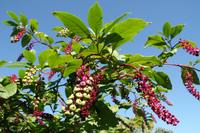Peduncle (botany)
This article needs additional citations for verification. (October 2013) |



In botany, a peduncle is a stem supporting an inflorescence, or after fecundation, an infructescence.[1]
The peduncle is a stem, usually green, though some peduncles are more or less florally colored or neutral in color, having no particular pigmentation. In some species, peduncles are leafless, though others bear small leaves, or even cataphylls, at nodes; such leaves generally may be regarded as bracts. The peduncle is the inflorescence base without flowers. When an unbranched peduncle has no obvious nodes, rises directly from a bulb or stem, and especially if it rises apparently directly from the ground, it commonly is referred to as a scape.[1]
The acorns of the pedunculate oak are borne on a long peduncle, hence the name of the tree.
See also
References
- ^ a b Shashtri, Varun. Dictionary of Botany. Publisher: Isha Books 2005. ISBN 978-8182052253
